My previous post touched on The Declaration of the Causes and Necessities for Taking Up Arms. The Declaration was one of several addresses issued by Congress to justify the necessity of armed resistance.The Continental Congress has previously issued the
"Olive Branch Petition", which was drafted by
John Dickinson. This petition was accepted by the Congress on July 5, 1775. The day after Congress debated "The Declaration of Causes".
(1)
Prior to this a committee was appointed to adopt a first draft of the declaration. This committee was comprised of John Rutledge, William Livingston, Benjamin Franklin, John Jay, and Thomas Johnson.
The shooting war had started on April 19, 1775 at Lexington - Concord, Massachusetts, but a declaration of war hadn't yet been adopted. The document has this at its heart:
"We are reduced to the alternative of choosing an unconditional
submission to the tyranny of irritated ministers, or resistance by
force. The latter is our choice."
The choice was clear. The Colonials had decided to continue war with Great Britain. Could there be any turning back? Most likely no, however I get the feeling if Great Britain would consider addressing the Colonies' grievances, bloodshed would be stopped. Trust though, was a major issue. Both sides did not trust one another. That was clear.
This declaration told the world why the battles were happening.
(2) The declaration stated that the shooting war was on, and here's why. So, was this America's first civil war? The Continental Congress was not declaring independence (that would happen a year later). It was declaring that this war was official on July 6, 1775. This declaration of war was drafted for General Washington to read to his troops stationed at Boston. If any of Washington's forces had any doubts, this document ended those.
The Declaration of the Causes and Necessity begins very similar to The Declaration of Independence. It notes how human life and inalienable rights are from God and no man has the right to take them away.
"...the inhabitants of these colonies might at least require from the
parliament of Great-Britain some evidence, that this dreadful authority
over them, has been granted to that body. But a reverence for our
Creator, principles of humanity, and the dictates of common sense, must
convince all those who reflect upon the subject, that government was
instituted to promote the welfare of mankind, and ought to be
administered for the attainment of that end."
The document does not demand independence, but lays out why hostilities are being waged. Thomas Jefferson and John Dickinson were named to the committee, to probably finish the draft. Jefferson's first draft was not accepted and Dickinson made the revisions.
(3)
Dickinson wrote: "Our cause is just. Our union is perfect. Our internal resources are great, and, if necessary, foreign assistance is undoubtedly attainable..."
(3)
The Congress spelled out that the colonies were their native land. An excellent point, since most were born in the colonies, and were raised with good intentions for a productive and fruitful life. There was a freedom of birthright. That freedom was being prohibited. Points were made that Parliament had imposed laws on the Colonies and that they, members of Parliament, had no right to do so. There was no defense from the Crown. The declaration spelled out that going to arms was the only defense against such tyranny and the protection of their property was paramount.
Congress wished to bring reconciliation with reasonable terms and to relieve the Empire of the calamities of civil war, but not at the expense of their liberties. Thus it was civil war.
I can't help but think of how many representatives knew the war would evolve to a war of independence. British authorities were harsh in their treatment and this would get worse. As events transpired, the war took on a much more deeper meaning for the Colonials. It was becoming an all or nothing fight and the Declaration of Independence was the beacon for a totally free nation.










